Shadow Work is a type of embroidery worked on semi-sheer or sheer fabric, with the bulk of the embroidery on the back of the design so that the color of the thread – or rather, a shadow of the color – shows through on the front of the fabric between two solid-colored outlines.
The stitch used in shadow work embroidery is essentially backstitch, but it is worked between two lines, alternating back and forth between the two lines with each stitch.
On the back of the fabric, the resulting closely worked herringbone stitch forms a layer of criss-crossing threads that shows through on the front of the fabric with just a hint of color between the backstitch outlines.
Last week, I had the opportunity to show someone how to do shadow work. This is the sample I worked up for the occasion.
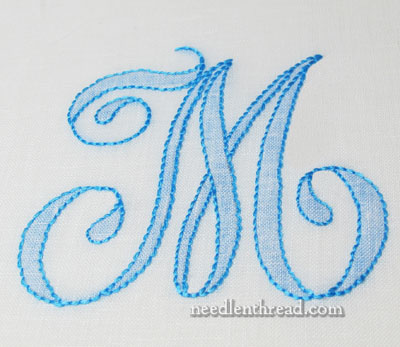
Shadow work can be used on many types of designs. Tanja Berlin, for example, offers some fantastic shadow work kits that includes subjects like tropical fish, a frog, flowers, a butterfly, and a forest, all worked on organza fabric with regular cotton floss.
Shadow work is a relatively quick way to work up a decorative initial, so I chose a letter for my sample. Letters that are made up of gently curved lines work really well for shadow work.
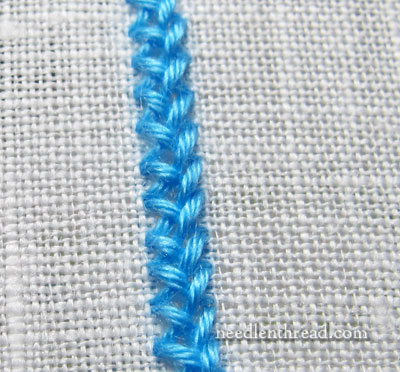
I’m not so fond of the front of shadow work, as much as I am fond of the back of it. And that’s just weird – how often do you prefer the back of your embroidery to the front?
But the back really is my favorite part of shadow work. I think the herringbone stitch is exceptionally pretty when the stitches are worked so close together.
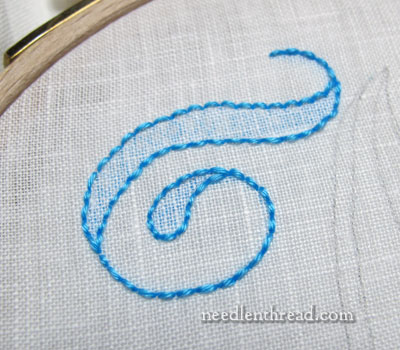
You can see that, on the front, the lines look like typical backstitch. I’m contemplating whipping the backstitch line to create a smoother, ropey line. I confess I’m not a huge fan of the look of backstitch by itself for outlines.
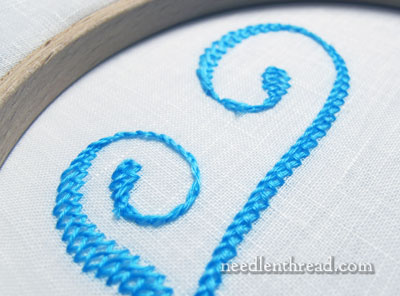
Ah – and the back again! The herringbone stitch takes curves gracefully.
Fabric for Shadow Work
With shadow work, the choice of ground fabric is important. The sheerer the fabric, the more distinctly the shadow shows through. If you want a more vivid color showing through your fabric, choose a sheer fabric like organza.
When it comes to shadow work, I’m a fan of the more subtle-color approach, so I like a slightly denser fabric. If you want more subtle color – like the paler color in the sample here – there are several fabric options. Shadow work can be done on fine cottons like batiste, and it can also be worked very effectively on the right kinds of linen.
In the sample, I’m working on Legacy’s linen cambric.
Oh. My. Goodness. It is a wonderful fine linen. It would be perfect for handkerchiefs, for fine whitework, and even for clothes. Baby gowns… delicate blouses… it is such nice stuff. It feels so good!
Legacy also makes “shadow work” linen – a handkerchief weight linen that works beautifully for shadow work, too. Because it is not as closely woven as the linen cambric, the color shows through slightly better on the shadow work linen. Later on, we’ll look at a sample of shadow work on the shadow work linen and compare the two fabrics.
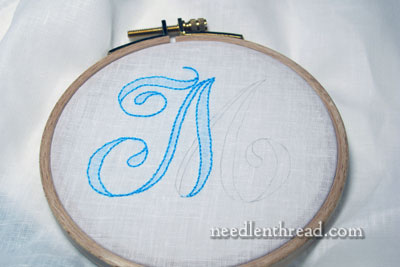
The thread I’m using is cotton floche, because floche just works great for this type of embroidery. But you can use any kind of embroidery thread, really, for shadow work – regular cotton floss, floche, coton a broder, flower thread, silk, or even wool.
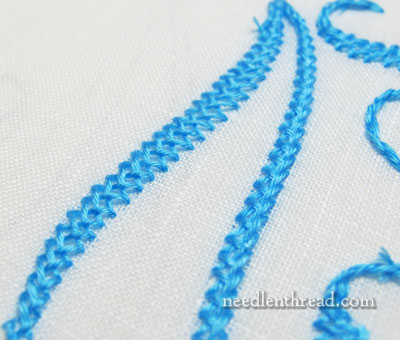
One thing to remember with shadow work – more so, practically, than any other type of embroidery – is that tweakers are totally undesirable. The back of the embroidery has to be neat, and all tweakers must be trimmed carefully. There are a few tweakers here that need trimming!
In addition to the tweakers, starts and stops have to be carefully considered. Running threads too haphazardly underneath the backs of the stitches can result in darker shadows and blotches on the front of the work, so a little ingenuity has to be practiced to ensure more discreet starts and stops to the threads.

Shadow work is a relatively easy technique, and it works up very quickly. A 2.5″ monogram like this one worked in satin stitch would take a good several hours from start to finish, while the same monogram in shadow work took less than an hour.
Alphabet Pattern
Ready to try your own shadow work monogram? You can find this alphabet – and 16 other monogram alphabets for hand embroidery! – in my ebook Favorite Monograms. Several of them will translate well into shadow work!
We’ll revisit the topic of shadow work embroidery later on as I work through some other samples. If you have any questions or comments about it, feel free to leave a comment below!







Would it be possible for you to do a video of shadow work? I’m really interested in seeing how this is done!
Hi, Grace – I’ll work on it. In the meantime, if you know how to do backstitch, you should be able to pick this up pretty quickly. Just alternate between the two lines, working one backstitch on one line, then moving across to the other line and work one back stitch. Then move across again, and work another backstitch, and keep going until the two lines meet again…. MC
Mary – This initial M is absolutely exquisite! I love how you teach us about a new fabric, new thread and gently walk us through a process that would be impossible to do if it had been in a book. Maybe that’s because we trust you. We know you’re the BEST! Thanks for being YOU!
Hi–wondering where Karen O. is from in MN?
Do you belong to the Needleworkers group in the Twin Cities by any chance? Would love to meet and see what you stitch.
Roxanne in Mounds View.
I’ve got a pink silk sheer organza which is going to be used for this gorgeous stitch! Thanks
Hello, Mary. I have never done shadow work and so I’ve never seen any “in person” but I’m very willing to learn. It’s beautiful in these examples, and now I would love to try it!
Thank you for all you do; you really help those of us who can’t get instruction any other way.
~ Dawn ~
Dear Mary
Thanks so much for this post. How interesting I’ve not seen shadow work before it looks lovely, I’ve not worked on fine ground fabric before so I should imagine a great deal of care is needed when stitching, how do you start and end threads on such fine fabric. I’ll be interested in your analysis on the comparision between Legacy cambric and Legacy “shadow work” as I would definitely like to try this, I can imagine using shadow work on fine organza to decorate cards or clothing. Thanks for this.
Regards Anita Simmance
I love your tips and techniques Mary. Thanks for sharing. For years I wanted to embroider some handkerchiefs (and napkins) but never knew what kind of material is best suited to make them from. I will have to order some of the two fabrics you mention. You mention organza. I never used organza but doesn’t it come in cotton, silk and nylon? Does it matter which one you use? I think the nylon can be burned through with a heated stylus or I’m thinking of something else. I read so much information the folders in my brain get mixed up at times-LOL.
Hi, Sandra –
Natural fibers are always easier to stitch on – they’re much easier on the threads. But as for napkins, hankies, and the like, organza would not be a fabric of choice. I think linen would be your best bet!
-MC
You are right, nylon melts as does polyester. One will melt into a black bead and one will melt into a tan bead and one smokes black and one smokes white, but I can’t remember which is which off the top of my head.
Most of the organza that we sell at the local fabric store is polyester, but silk organza was used as the sheer fabric for Princess Kate’s wedding gown. Melt spinning is a quick way to finish raw edges of both polyester and nylon fabrics so they won’t fray. A stylus or soldering iron works great for this, but I have even used a candle flame and slid the edge through the flame being careful not to let the fabric burn.
Thanks for your reply Mary and all your info Debbie. I was referring to the Legacy’s linen cambric that you said was good for handkerchiefs and I want to try but the organza, I just wanted to know in general which is best. Thanks for all the wonderful info, it certainly cleared up some of my questions.
Wonderful information! Floche is great for shadoe work – it ‘fluffs’ when you wash it, which gives even beter coverage on the front!
Oh, how fun! I’m going to have to try this at some point, but I already have three projects to juggle.
Hi Mary,
Love the shadow work monogram; just my letter too!!
Would you be able to tell us where we can find the style of monogram you used for this, would love to work this.
Thanks as ever for your fabulous blog. Hope you are keeping well.
I often take individual letters from almost any font right out of my computer. If you print them out as big as you want you can trace the outside edges of the letters and have the outline ready for monograms or appliques. If you print in color you can even test different colors to see how they work on our ground fabrics.
Hi, Marysia – thanks for your comment! The alphabet is an old Rouyer one, I believe, but I’ll have to look that up to be sure. I’ll have it on the website eventually. -MC
I, too, would love to see a video of this stitch. I notice you have your hoop set up with the ‘backstitch’ facing you, but in my head isn’t it easier to stitch with the herringbone? I feel like I’m standing on my head looking backwards on this one- lol.
Hi, Heather – since the backstitch is what shows on the front of the fabric, I think it’s important to see it while you’re working it, to keep it as neat as possible. I do know some stitchers who work the technique from back to front, but I prefer seeing the front, since it’s the most visible part on the finished piece. -MC
Mary, it’s simply beautiful. Thanks for showing us and telling about the fabrics, too. I know it’s odd, but I forget about shadow work as being an option. It’s so elegant, though.
So beautiful! So perfect!!!
Bardzo podoba mi się ten haft. Wykonałam kilka prac.Jest delikatny, chociaż wolę biały.
Pozdrawiam
Anna z Polski
Hi, Mary, I’m a beginner at embroidery. I absolutely love this shadow work! I have never seen it before. I’m going to try this soon. I’m so glad I found your website. You are very helpful and inspiring. I look forward to your newsletters.
I would like to see the whipped back stitch. I’ve done a little shadow embroidery and I’d like to learn more. Thanks for choosing this topic!
Hi, Ruth – yes, I think with the next one, the edge will be whipped, just to illustrate the difference. MC
Aloha Mary,
Beautiful work as usual! I have done shadow work and like it. I would caution against making anything that is too wide as the stitches on the back could get caught on something and pull the work out of line.
Also, AVOID nylon at all costs. It is not worth the time and effort to work on it. I did a silk organza embroidery edged in nylon- never again. Save your pennies to buy the best material. It does not drape as linen, cotton or silk organza.
A word of caution for those that have to buy online – always read the fiber content of the fabric in the description. Many sellers say silk when they actually mean “silk like.” For those of us that have limited local resources and use online shopping, read the description/fiber content carefully.
Love your work.
JI
Jacquelin,
You are absolutely correct. If you read the signs at the local fabric stores, they say linen and linen-like fabrics and silk and silk- like fabrics. A $$$-like fabric is usually a polyester or rayon blend that won’t shrink or wrinkle like the real thing and can be washed in the machine. They are not always cheaper, but they should be.
Say whatever they want, nothing drapes like linen, washes like cotton or is as smoooth as silk except the real thing. Rayon, polyester and nylon blends come close, but they do not breath the same when we wear them and they stretch when we embroider or quilt with them and require extra stabilizer to keep them square. If I’m going to the effort to hand embroider, I always use the real thing.
What a lovely technique. Thanks for sharing it. And I’ll definitely be checking out those ATanja Berlin kits you linked to.
How pretty! I want very much to try this after seeing your elegant monogram.
This is so beautiful! But I’m not understanding it!!! I would love to see a video as well. I have some white and ivory silk organza, which I’d love to use. Where do you get this linen? I feel like I should know – but I’m drawing a blank! Thanks for sharing this, and I hope you share more on this technique 🙂 Karen
Hi, Karen – you can find the linen through Hedgehog Handworks, Needle in a Haystack, and other fine needlework shops that carry Legacy linens. Both are really nice – I’ll have a more in-depth comparison up later on… MC
Mary,
Trapunto quilting is shadow work like this as well, only instead of orderly stitches, colored yarns or fibers are stuffed into the spaces giving it a puffed up texture. If the top is white, the colored fibers show through making lighter tints of the darker or brighter colored yarns. Knowing how it is done, does not mean I have done it, but it is definitely on my ” need to do” list. One of these days it will happen.
This is a form of needlework I’ve actually done. I find the most difficult thing about it is that the backstitches on the surface need to NOT be exactly the same length around the curves – oh, that fries my Western, symmetry-loving, mathematical brain! The complicated bit is keeping the herringbone stitches at a constistent angle, so you maintain coverage in back.
Yes you’re right! Shorten up the stitches on the inside curves, lengthen the stitches slightly on the outside curves – otherwise, one side will get much farther ahead than the other!
No, don’t whip the backline. It doesn’t need to be camouflaged because your stitches are so neat. The grace and simplicity of this pattern makes it stand out. Good job, Mary.
I love shadow work. Working on organza, you have to be extra careful how to finish and start.
Do you use away knot to start ? How do you finish your stitch?
I am still looking for the jiggles! I think long sleeves will cover them.
Lovely piece and I want to give it a try.
Deb
i adore shadow work,excellent description.
I also like the back of shadow work more so than the front. It is so beautiful.AM
Please show your readers some more picturesque shadow work, a la Tanja Berlin , and other artists who use the technique pictorially—so beautiful to behold!
So enjoy waking up to you daily—thank you for enriching my life!
Gail
As I look at the lovely back and read how much you like it, why NOT devise a monogram done with herringbone so that you can enjoy it from the front? No, it wouldn’t be shadow work, but…
Hi, Carla – funny you should say that – great minds think alike? I’ll show you the results soon! -MC
I love your columns, especially the ones that are informative about as particular topics such as shadow work. I am a newsletter editor for a chapter of EGA and wondered if I might use your columns in my newsletter.
Thank you.
Hi, Cindy – Feel free to drop me an e-mail at mary (at) needlenthread (dot) com, and we can discuss this further. Thanks a bunch! ~MC
I have ordered ” in fine style” and now I cannot remember where the show is that this book is the catalogue for…Was it the V&A?
Thank you for all the inspiration you provide,
Grace
It’s at Buckingham Palace, Grace. Here’s the link: http://www.royalcollection.org.uk/exhibitions/in-fine-style-the-art-of-tudor-and-stuart-fashion-QGBP
Thank you sooooo much I do appreciate the Shadow Work Information. I wrote a comment on this site asking where Shadow Work was as I couldn’t find it, being new to your site.. and wallah in no time at all it appeared in my InBox. I belong to an Embroiderer’s Guild here in the Gold Coast,Queensland Australia.
A member of the Guild forwarded your email to me suggesting I subscribe to your Newsletter. I too will forward on to others.
Thank you sooo much once again for your genorosity in sharing.
hugs Judi
Beautiful! Love all the curves in this font. Are these letter designs on your site somewhere?
Hi, Alicia – not yet, but it will be in the future! – MC
Hi Mary,
I’m keenly interested in shadow work although I’ve never seen it done.
Please do a video when you can. I’m loving the beautiful monograms too. I’m with Marysia hoping to see other letters for us to stitch. Thanks for sharing so much Mary. We love your many talents and knowledge.
Roxanne
Hola disfruto siempre de sus bordados y aprendo mucho . Viendo las paguinas me gusto mucho un monograma o abedecedario en punto sombra pero sale solo la letra ( M-A )me gusta saber de donde copiar los patrones de estas letras y ademas un video para hacerlas seria super completa la informacion.
Muchas gracias y felicitaciones por su paguina
hello.this work is very nice.thank you very much
I have recently found your website and it is not a favorite. I would be interested in your course if you offer it on shadow work. 🙂 It’s lovely.
C
Correction. NOW a favorite!!
Hi Mary .. I also love Shadow work … & especially the back! In fact, the first time I did some, I was so in love with the back that I was tempted to make it the front! 🙂
You referred to ‘tweakers’ & ‘jiggles’ … Would you please enlighten me to their meaning??
Cheers & Thanks again for an interesting article … 🙂
Hi, Wendy! “Tweakers” are little thread ends that stick out and need trimming. “Jiggles” are little places in the line of stitches that “wobble” a bit – a wobbly bit of the line. Trust me – these aren’t technical terms. I just sort of make ’em up as I go, because they seem to work in the context. 🙂 MC
me gustaria todas las letras del monograma que aparece la letra M (eme)muchas gracias ya que me gustaron mucho
Hi
Love your website! I’m about to shadow embroider on a swiss neroli cotton that I’m using to make an ‘envelope’ that will hold a christening gown but I can’t fine a font as lovely as the one you have used in your examples. Can you help me source it?
Many thanks Patrice
Boa tarde,
Gostaria de saber se existe previsão do tutorial do ponto sombra. Shadow stitich
Engracia-brasil
I would love to teach shadow embroidery at my local chapter of EGA. Do you know of a source for an alphabet like the “M” you used? I enjoy your Blog so much. Thank you for sharing your knowledge of embroidery!
Vera in WV
Hello Mary,
So I want to use a capital A in shadow embroidery for some pillow cases. I LOVE this M. It is EXACTLY what I am looking for. I have been perusing font sites and looking online and can’t find the A version of it anywhere. You mentioned that it was an old Rouyer (in one of the comments below) but I can’t find anything about Rouyer (fonts?) online at all.
Do you happen to know where you got this? Or does anyone else know? I have resisted bugging you for several weeks but since I can’t find it after lots of online scrolling – I thought I would ask. In a pinch I will try to create my own using the M as a template – but since the font lends itself so well to shadow work, it would be nice to have the whole alphabet.
Thanks so much. Your website is such a lovely and helpful resource!!
Hi, Carrie – can you email me through the contact page on the website, and I’ll see what I can do. I’m not home at the moment, but if you email, when I get home, I’ll remember to look it up. If you don’t email, them I will end up forgetting almost as soon as I publish this reply! :-/
Boa tarde, Maria,
Gostaria de saber se você vai preparar tutorial para esse tipo de bordado.
Obrigada
I want to make a wedding hankie for my niece. A couple of questions:
How do you start and end your stitches when you need to be so careful with knots? pertaining to shadow stitching. If I use a ‘blank’ handkerchief, how would I hoop it? Or do you ever use the linen handkerchiefs, hemstitched, lace edged, etc., that are available?
I’m doing my first shadow work – on a piece of Swiss batiste, with l ply of cotton embroidery floss. I can see the criss crosses on the back, through the fabric (looking from the front). Am I supposed to be able to see that? Thanks for your help,
Hi, Bobbie – On some shadow work, depending on the design and the designer and the look wanted, you might want to see the crossing stitches on the back. With monogramming and the like, I prefer a more filled look. If you want a more solid fill, you’ll probably need to use more than one ply of floss. You want the floss to fill the stitch well, so a heavier thread will help – try two or three plies. In this example, I’m using cotton floche, which is about the thickness of 2 plies (maybe a little finer), but it’s a softer thread, so it “spreads” more. ~MC
JE VOUS REMERCIE MARY CORBET SALUT
Bonjour, je voulais avant tout vous remercier du travail magnifique que vous mettez à disposition des brodeuses internautes.
J’aimerais savoir quelle est la longueur des points que vous broder pour le point d’ombre. Je m’y suis mise récemment, et j’ai l’impression que mes points sont un petit peu trop petits ( un peu moins de 1 millimètre) . Merci si vous pouvez répondre, sinon, merci mille fois pour votre site, et les broderies magnifiques qui me font tant rêver.
Olá mary, feliz 2016. Achei diferente A parte de trás do monograma. Tentei e não consegui fazer. Seria maravilho se você voltasse a falar sobre esse ponto tão lindo. Acho que suas seguidoras estão ancilosas para aprender essa maravilha de ponto. Abracos
Would it be possible to show how to shadow stitch a rectangular shape…the leaf I can manage
Mary, I could never see the point of shadow work on hankies. Blow your nose and the hankie is just a crumpled bit of cloth.
My Mother used to do it on the top and sleeves of wedding dresses and the hem of christening dresses.
Better done as a sample and left in a book or in a frame showing what both sides looks like(do 2). It does not stand up to washing.
It is sweet and pretty but purely decorative.
MM
Do you prefer to work from the back or from the front?
With shadow work, I work from the front, because that’s the part that will be seen, so I want to make sure that the double rows of backstitch on the front are as neat as possible.
Absolutely gorgeous work!
I’ve been asked by my granddaughter to make her a tallit for her Bat Mitzvah. She has chosen white chiffon and a shadow-stitch border. Problem: how do I work in the beginning and ends of the threads without having them show?
Thanks,
Rachel
Hi, Rachel – I would use Anchor stitches on a line to start your threads (you can find that tutorial here), or, if you’re using two strands of floss (like DMC stranded cotton) this two-stranded invisible start will work well. To end the threads, you would whip the thread around the backs of the stitches, along the edge of the design (where the backstitching shows on the front), and then hitch the thread through itself once and trim close. Hope that helps!
On the ebook with the 16 alphabetic letters, do they only include the letters displayed or are all 26 letters included in each style?
If you mean my Favorite Monograms e-book, the cover is showing you just the 16 different styles of alphabet, but there are all 26 letters for each alphabet in the e-book. Hope that helps!
Hi, I’m super new and know very little but I’m learning a lot following your you tube tutorials. But I have seen you use the word tweaker a few time and I’m not entirely sure what you mean since the definition of a “tweaker” in Utah is a meth addict. Hahaha. I’m sure it’s not that.
Also, you have an ebook with an alphabet sampler pattern I just love but I wondered if you could tell me where you bought the beautiful colored fabric you used, and do you think it would be suitable for putting in a quilt? If not do you have advice about what fabric would be?
Hi, Kathy – oh. Gosh. I’ve never heard tweaker used that way! LOL! I must be pretty sheltered out here in Kansas. I’ve always used the term (since I was a kid) to mean a piece of thread (or even a hair on your head) that sticks out in an unwanted or unsightly manner! The colored fabric backgrounds in Stitch Sampler Alphabet are linen. They can be used on a quilt, but linen isn’t necessarily a common quilting fabric. The letters can be stitched on cotton, too.